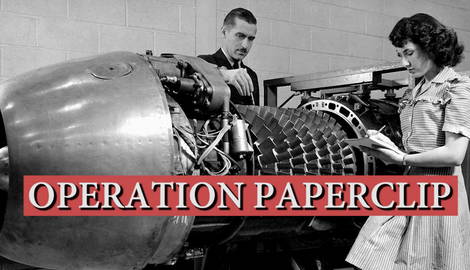
Operation Paperclip (formerly known as Operation Overcast) was initiated in 1945 by the newly established Joint Intelligence Objectives Agency (JIOA) of the United States. As tensions between the Soviet Union and the United States over global domination grew, the Truman administration envisioned Germany’s scientific and technological advances during World War II as a valuable potential asset, particularly for military and rocketry development.
Origins of Operation Paperclip & The Osenberg List

Germany’s much anticipated Operation Barbarossa to seize control of the Soviet Union in June 1941 ultimately failed. Following Japan’s attack on Pearl Harbor in early December 1941, the United States joined the Allied forces (Great Britain, France) and entered World War II. The geopolitical landscape was shifting quickly and not to Nazi Germany’s advantage.
The Nazi army’s resources were exhausted during Operation Barbarossa. In 1943, Adolf Hitler issued an order to remove all scientists and technicians from battle to accelerate research and development. The order intended to strengthen Germany’s self-defense capabilities in the event of an impending Soviet attack. Author Dieter K. Huzel described the event in his book Peenemünde to Canaveral:
“Overnight, PhD.s were liberated from KP duty, masters of science were recalled from orderly service, mathematicians were hauled out of bakeries, and precision mechanics ceased to be truck drivers.”
Reportedly, nearly 4,000 rocketeers were relocated to Peenemünde, coastal Germany, the largest military research center in Europe from 1936 to 1945.
Engineer and scientist Werner Osenberg, the head of the Military Research Association, was tasked with identifying, locating, and assessing German intellectuals for their ideological and political liability. The final result of this research was the so-called Osenberg List, composed of prominent scientists, engineers, and technicians from Germany, most of whom were on the frontlines of World War II.
As World War II headed to its end, Nazi Germany still astounded the Allied forces with its advanced military equipment, including rockets, jet fighters, V-1 unpiloted aircraft, and V-2 missiles. The progress did not go unnoticed.

The great powers, and particularly the United States, aware of Germany’s defeat and an increasingly polarizing world, intended to exploit Nazi scientific advancements to enhance its own military capabilities. In the short term, Japan still posed a significant threat to the Allied powers. New military developments would assist the United States in neutralizing Japanese forces. In the long term, future confrontations with the Soviet Union in the context of the upcoming Cold War and arms race would require advanced scientific infrastructure.
Additionally, the United States leadership feared a future German resurgence, as happened after World War I. The exploitation of the German intellectual capital would contain Germany’s future imperialist aspirations. This vision quickly turned into a spontaneous race for German intellectuals and scientists, along with any relevant data and secret papers.
General Henry H. Arnold, the commander of the Army Air Forces in the United States, established the Air Technical Intelligence Services in 1944 with the mission of locating and obtaining Nazi military research materials and secret information. Operation Overcast was the original codename of these efforts. The establishment of a new intelligence service was also motivated by a setback in American military technologies, particularly the challenges of targeting German jet fighters, such as the V-2 rocket. This obstacle might have compromised Operation Overlord, launched in June 1944 to liberate Germany-occupied Western Europe.

One of the first tangible results of the operation was the launch of Operation Lusty on April 22, 1945. The name is derived from the initials of the Luftwaffe, the German Air Force, one of the largest air forces in Europe. Operation Lusty merged wartime American intelligence teams and established a united Exploitation Division, providing guidance for identifying and localizing important documents and materials throughout the European continent.
The search proved successful. In March 1945, at Bonn University, a Polish laboratory technician found pieces of the Osenberg List stuffed in a toilet. The list subsequently reached American intelligence services. The United States Army Major Robert B. Staver, Chief of the Jet Propulsion Section of the Research and Intelligence Branch of the Army Ordnance Corps, utilized the Osenberg List to compile his own list of German scientists to be captured and transferred to the United States.
Advancements of Operation Paperclip & Controversy

In August 1945, Colonel Holger N. Toftoy, chief of the Rocket Branch in the Research and Development Division of Army Ordnance, introduced one-year contracts to the selected German rocket scientists to work for the United States. In total, 127 individuals accepted the offer. The United States pledged to relocate their families as well.
A small group of German rocket scientists first arrived in Texas in September 1945: Wernher von Braun, Erich W. Neubert, Theodor A. Poppel, August Schulze, Eberhard F. M. Rees, Wilhelm Jungert, and Walter Schwidetzky. They were some of the most prominent scientists within the German intellectual circles, as well as closely affiliated with the Nazi Party. Immediately, they were tasked to work on rocket testing at White Sands Proving Grounds as “War Department Special Employees.”

The arrival of high-level Nazi scientists in the United States was controversial. Almost simultaneously, on September 2, 1945, Japan surrendered in World War II. Protest broke out, and with World War II almost to its end, there was no need for Nazi scientists and their families to reside in the United States.
The urgency of technological advancements and the almost immediate progress of the newly moved intellectuals forced the authorities to seek ways to bypass the opposition. In March 1946, the United States renamed Operation Overcast to Operation Paperclip. The name “paperclip” derives from the fact that the dossiers of Nazi scientists and engineers were marked with paperclips.

Wernher von Braun, for example, despite his controversial affiliation with the Nazi Party, played a pivotal role in the successful development of the Redstone, the United States’ nuclear-armed ballistic missile program. He and his team, composed of about 125 scientists, successfully developed and launched Explorer I, the first United States satellite, following the Soviet Union’s announcement of the successful launch of Sputnik in 1955. Later, in 1960, he became part of NASA, developing the Saturn V rocket, which was used in the Apollo program, ultimately leading to the successful landing of the United States on the moon in 1969. During this time, he held the position of director of NASA’s Marshall Space Flight Center.
Hubertus Strughold is another well-known researcher of the Third Reich who relocated to the United States in 1947. Strughold served as a chief scientist of the Aerospace Medical Division at Brooks Air Force and studied space medicine, leading clinical research on the physiological and behavioral effects of space travel and the space environment on the human body.
In 1948, Dr. Hubertus Strughold became the first Professor of Space Medicine at the Air Force School of Aerospace Medicine. His contributions to the development of aerospace medicine were so fundamental that he was regarded as the “Father of Space Medicine.” In Germany, Dr. Hubertus Strughold led the German Air Force Institute of Aviation Medicine. The institute was known for its torturous medical experiments on the prisoners of the Dachau concentration camp. Strughold denied any affiliation with war atrocities conducted by Nazi Germany. His figure, however, remained controversial throughout history. American historian Mark L. Kornbluh stated:
“American scientific recruiting teams ignored the inhumane basis of much of their work and treated Nazi scientists as both colleagues and friends…Dr. Strughold pioneered aviation medicine through gruesome experiments conducted on prisoners in Dachau.”

During World War II, Reinhard Gehlen served as Adolf Hitler’s top high-level intelligence officer on the Eastern Front. Gehlen actively engaged in the preparation of Operation Barbarossa, a Nazi attempt to conquer the Soviet Union. In 1945, Nazi Germany was defeated. Gehlen offered the United States access to the Nazi intelligence archives and his personal intelligence information about the Soviet Union in exchange for his, his family’s, and his colleagues’ freedom. The United States, aware of Gehlen’s expertise and intelligence contacts throughout the European continent, accepted the offer. As a result, Gehlen and his family relocated to the United States as part of Operation Paperclip.
In collaboration with US intelligence agencies, Gehlen established an espionage agency, the Gehlen Organization. When Germany was divided, Gehlen became the head of the Federal Intelligence Service of West Germany (BND), established in 1956. He employed a number of former Nazi officers.
Public attention to Gehlen’s controversial activities in West Germany was drawn only in 2005, when the National Security Archive made public the CIA’s secret documentary history, Forging an Intelligence Partnership: CIA and the Origins of the BND, 1945–49. The CIA documents reveal that Gehlen’s intelligence network faced significant setbacks. As the document states, the BND became a “double-edged sword,” which “boosted the Warsaw Pact’s propaganda efforts and suffered devastating penetrations by the KGB.”
Throughout the 1950s, 86 aeronautical engineers were positioned at Wright Field, a top-secret World War II Air Force test center in the United States. The United States Army Signal Corps employed 24 German scientists with backgrounds in physics, chemistry, geophysics, and electronics engineering.
Legacy of Operation Paperclip

Due to its complex and controversial nature, Operation Paperclip remained secret throughout much of the 20th century. Approximately 1,600 German scientists and their families were relocated to the United States, many of whom managed to erase any mention of their Nazi pasts from their histories.
The truth about these scientists emerged slowly. During the 1970s, a number of hearings were held in the United States House of Representatives, though without a tangible result. It wasn’t until 2006 that the Office of Special Investigations (OSI) published an official record of Operation Paperclip.
The OSI’s findings acknowledged that Nazis had been knowingly granted entry to the United States. The 600-page report stated, “America, which prided itself on being a safe haven for the persecuted, became, in some small measure, a safe haven for persecutors as well.”
Operation Paperclip remains controversial to this day, as it is still under investigation. American authorities made morally corrupt decisions in exchange for preserving American and even international security. As President Harry Truman declared in 1963 regarding Operation Paperclip, “this had to be done and was done,” leaving the question of Operation Paperclip’s legacy open to debate.










